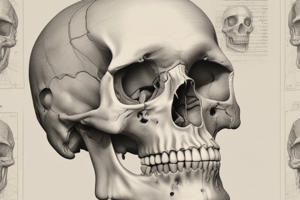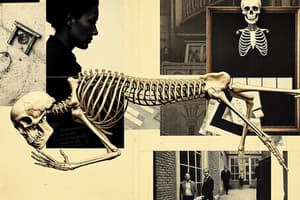Podcast
Questions and Answers
Which of the following best describes the application of forensic anthropology?
Which of the following best describes the application of forensic anthropology?
- The examination of ancient civilizations using modern technical methods.
- The study of human behavior in archaeological contexts.
- The analysis of skeletal remains to determine cause of death.
- The use of anthropological theory and methods to solve legal problems. (correct)
What is the primary reason children and infants have a higher number of bones compared to adults?
What is the primary reason children and infants have a higher number of bones compared to adults?
- Children have more dense cortical bone.
- Infants have a larger quantity of trabecular bone.
- Children and infants experience constant bone remodeling.
- The presence of ossification centers. (correct)
Which of the following best describes the taphonomic context of a body?
Which of the following best describes the taphonomic context of a body?
- The position of the body found in a clandestine grave.
- The immediate environment where the body is discovered (correct)
- Changes in the skeleton postmortem such as bone remodeling.
- The biological profile including age, sex, and ancestry.
A forensic anthropologist observes a skeleton with a shallow sciatic notch and a U-shaped subpubic angle. What sex would they likely classify the remains as?
A forensic anthropologist observes a skeleton with a shallow sciatic notch and a U-shaped subpubic angle. What sex would they likely classify the remains as?
A forensic anthropologist is assessing age-related changes in a skeleton. Which of these observations would be most consistent with an older individual?
A forensic anthropologist is assessing age-related changes in a skeleton. Which of these observations would be most consistent with an older individual?
Which characteristic is used to identify a skeleton's sex after it has reached adolescence?
Which characteristic is used to identify a skeleton's sex after it has reached adolescence?
What information can be derived from analyzing the strontium levels in bones?
What information can be derived from analyzing the strontium levels in bones?
What is a significant consequence of osteoporosis?
What is a significant consequence of osteoporosis?
Which factor contributes to the identification of human versus non-human bones?
Which factor contributes to the identification of human versus non-human bones?
During the assessment of a biological profile, which characteristic is not included?
During the assessment of a biological profile, which characteristic is not included?
A forensic anthropologist examining a skeleton observes a fully ossified sagittal suture. What does this observation indicate about the individual's age?
A forensic anthropologist examining a skeleton observes a fully ossified sagittal suture. What does this observation indicate about the individual's age?
Which of the following skeletal indicators is NOT directly used to estimate an individual's age?
Which of the following skeletal indicators is NOT directly used to estimate an individual's age?
A forensic anthropologist is examining a skull with a fully ossified squamosal suture. What can be concluded about the individual's age?
A forensic anthropologist is examining a skull with a fully ossified squamosal suture. What can be concluded about the individual's age?
A forensic anthropologist is examining the pelvis of a skeleton and observes a rough, grooved surface on the pubic bones surrounding the pubic symphysis. What can be concluded about the individual?
A forensic anthropologist is examining the pelvis of a skeleton and observes a rough, grooved surface on the pubic bones surrounding the pubic symphysis. What can be concluded about the individual?
In the context of skeletal analysis, what does 'in situ' refer to?
In the context of skeletal analysis, what does 'in situ' refer to?
Which of the following bone features is LEAST likely to be helpful in determining the age of a skeleton?
Which of the following bone features is LEAST likely to be helpful in determining the age of a skeleton?
A forensic anthropologist observes that a skeleton has a pronounced bowing of the legs, thinning of the skull, and a deformed spine. What could this indicate about the individual's nutritional status?
A forensic anthropologist observes that a skeleton has a pronounced bowing of the legs, thinning of the skull, and a deformed spine. What could this indicate about the individual's nutritional status?
Which of the following is NOT a characteristic typically associated with a female pelvis?
Which of the following is NOT a characteristic typically associated with a female pelvis?
A forensic anthropologist is examining the ribs of a skeleton and notices that the fourth rib attached to the sternum has a porous and pitted surface. What would be the BEST conclusion based on this observation?
A forensic anthropologist is examining the ribs of a skeleton and notices that the fourth rib attached to the sternum has a porous and pitted surface. What would be the BEST conclusion based on this observation?
Which of the following is NOT a characteristic used to estimate ancestry from skeletal remains?
Which of the following is NOT a characteristic used to estimate ancestry from skeletal remains?
Flashcards
Osteology
Osteology
The study of bones, essential for forensic anthropologists to analyze skeletal remains.
Biological Profile
Biological Profile
The estimation of age, sex, ancestry, and other biological characteristics from skeletal remains.
Estimating Age
Estimating Age
The process of determining the age of an individual based on skeletal development and dental features.
Taphonomy
Taphonomy
Signup and view all the flashcards
Clandestine Grave
Clandestine Grave
Signup and view all the flashcards
Osteoporosis
Osteoporosis
Signup and view all the flashcards
Osteometry
Osteometry
Signup and view all the flashcards
Identification (Forensic Anthropology)
Identification (Forensic Anthropology)
Signup and view all the flashcards
Bones and Geography
Bones and Geography
Signup and view all the flashcards
Distinguishing Male from Female (Skeleton)
Distinguishing Male from Female (Skeleton)
Signup and view all the flashcards
Subpubic Angle
Subpubic Angle
Signup and view all the flashcards
Ossification
Ossification
Signup and view all the flashcards
Pubic Symphysis
Pubic Symphysis
Signup and view all the flashcards
Skull Sutures
Skull Sutures
Signup and view all the flashcards
Cartilage Ossification
Cartilage Ossification
Signup and view all the flashcards
Advanced Decomposition Fracture
Advanced Decomposition Fracture
Signup and view all the flashcards
Rickets
Rickets
Signup and view all the flashcards
Osteoarthritis
Osteoarthritis
Signup and view all the flashcards
Forensic Anthropology
Forensic Anthropology
Signup and view all the flashcards
Study Notes
Forensic Anthropology
- Forensic anthropology is the application of anthropological theory and methods to forensic problems.
- It is extremely important when dealing with skeletal remains.
- Osteology (study of bones) and odontology (study of teeth) are critical areas of knowledge.
- Determining if skeletal remains are human and whether they have forensic importance is crucial.
- Anthropologists need knowledge of skeletal development in children and infants.
- Adults have 205 bones, while children can have up to 405 due to differences in ossification.
- Post-mortem alterations need differentiation from pre-mortem alterations.
- Anthropologists are frequently called to participate in body recovery and analysis of the taphonic context (the environment in which a body is found) which is helpful in interpreting post-mortem processes.
- Biological Profile analysis includes age, sex, ancestry and estimations of height based on measurements.
Recovering Remains
- In clandestine graves or buried sites, a grid is established, and areas photographed before any excavation work.
- Ground Penetrating Radar (GPR) is used to detect remains.
- Remains are moved to a staging area and detailed records for evaluation.
- Taphonomic context (immediate environment) assists in understanding how long a body has been there.
Determining Sex
- Identifying sex involves examining anatomical features like the sciatic notch (narrower in males) and subpubic angle (wider in females) of the pelvis.
- In skulls, the males have more robust features in brow ridges and the mastoid process compared with females.
- Specialized measurements are important.
Determining Age
- Estimating age is based on skeletal development and fusion of bones.
- Dental development is significant, particularly for younger individuals.
- Sutures (joints connecting bones) provide clues about skeletal maturation (bones fusing by particular age ranges).
Identifying Individuals
- Positive identification requires more than just determining sex and age.
- Unique characteristics or traits like DNA, fingerprints, dental records, x-rays, or unique physical features are crucial for definitive identification.
Importance of Forensic Anthropology
- Identifying human remains and providing information about the victim.
- Assessing the skeletal structures and elements like age, sex, and trauma.
- Reconstructing the skeletal facial features for possible identification.
- Analyzing the contexts of the remains for additional information.
Science of Bone
- Osteoporosis affects bone density and potentially causes a hunched appearance.
- Strontium found in bones can provide information about where the individual lived, and isotopes found there.
How to Distinguish Ancestry
- Features, like nasal openings, prognathism, and the flatness of the face, help classify ancestry.
- Skeletal analysis is used to estimate ethnicity
Broken Bones
- Broken bones can show signs of the break, and elasticity changes during decomposition
Preliminary Field Observations
- Examine colour and texture of bone fragments to assess it as possible human remains.
Skeletal Trauma Analysis
- Analyzing skeletal remains for signs of trauma (antemortem, perimortem, postmortem)
- Broken bones and defensive injuries are assessed.
- Identifying blunt trauma or gunshot wounds.
- Analyzing animal-related damage.
Teeth
- Identifiable characteristics of teeth across stages of development; teeth come in & fall out
- Dental records can be used to identify individuals.
Skull Sutures Marks
- Sagittal, lambdoidal, squamosal sutures fuse at specific ages.
- Fused sutures indicate the individual is older than a certain age (generally 30+).
Public Bone & Sternal Rib Surfaces
- Analyzing public bones and rib surfaces for details of how long the body has been buried.
- Surface characteristics like ridges provide information.
Pelvis
- Female pelvises are wider than male pelvises (subpubic angle, coccyx or tail bone)
- Evaluating pelvises helps determine age and if the individual was pregnant during death.
DNA Analysis
- Nuclear DNA or mitochondrial DNA can help identify remains.
Photographic/Video Superimposition
- Overlaying a skull image onto a photograph or video.
- Craniofacial reconstruction can give a "realistic" picture.
Craniofacial Reconstruction
- Creating a model of facial features.
- Approximation of the person's appearance before death.
General Notes
- Definitions of various terms, measurements, and identification methods.
- Different types of bones' identification, measurement techniques, and analysis methods.
Studying That Suits You
Use AI to generate personalized quizzes and flashcards to suit your learning preferences.




